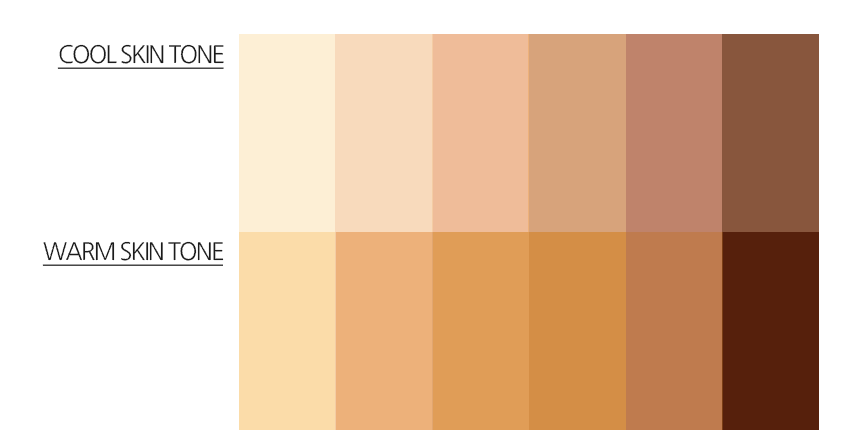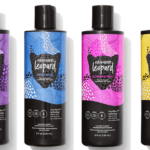Have you ever been confused about which foundation to use for your skin tone? It can be pretty overwhelming just to stand in the makeup aisle and feel clueless about which foundation to choose.
Well, worry no more! I’ll help you sort out this dilemma. Choosing the right foundation will help keep the rest of your makeup flawless.
To find the perfect foundation, you will need to identify your skin undertone. There are three skin undertones: cool, warm, and neutral.
- If you have cool undertones, pick a foundation with a red, rose, pink, or blue base.
- If you have warm undertones, choose a foundation with a yellow or gold base.
- For neutral undertones, pick a foundation that isn’t overly yellow or pink.
Read on to see my favorite skin tone charts, as well as how to find your skin tone and foundation.
Also, for an excellent foundation for women with cool undertones, take a look at our top pick:
Click here to see it on Amazon.
Skin Tone Chart – My Top 3
To find the best foundation for your skin tone, you need to determine your skin tone and skin undertone.
Knowing these two things is useful, especially when confronted with a wide array of foundation shades, not to mention an overwhelming list of brands. So, you just can’t randomly pick one on the display shelf.
Below, I’ll list three skin tone charts or skin tone palettes I like to use for myself and my clients.
This first skin tone chart shows skin tone and pigment beside an example photo:

The next skin tone chart I like as gives a wide range of skin tones with various descriptive names:

The third skin tone chart I like to go by shows cool vs warm skin tone shades:

Next, I’ll describe how to find your skin tone and skin undertone.
Finding Your Skin Tone
Skin tone is your complexion or the surface color of your skin. Your specific and unique skin tone can change depending on the amount of exposure you have to the sun.
The more you are exposed to the sun, the darker, tanner, or redder your skin tone becomes. There are generally three categories of skin tone: fair, medium, and dark. See the skin tone chart below.
1. Fair or Light Skin Tone
People who fall under this category tend to burn easily under the sun. They are often people from Northern European countries and other countries that get extended months of snow.
Fair skin types most commonly have freckles, including other types of blemishes. They also tend to have sensitive skin.
2. Medium Skin Tone
People with medium skin tone will tan well under the sun. They are usually people from the Southern part of Europe or Northern Asia. If you have an olive skin tone or a well-balanced beige appearance, you fall under this category. You also tend to have warm undertones.
3. Dark Skin Tone
Those who have dark skin tones are from parts of the world that see a lot of the sun. They are usually from the Middle East, parts of Asia, and Africa. People with dark skin tones are more prone to hyperpigmentation and skin damage due to sun exposure.
Dark skin tone also has sub-classifications, such as brown, dark brown, and black-brown. Sometimes, these skin tones are described as ‘deep’ or ebony.
Finding Your Skin Undertone

Skin undertone is the subtle hue underneath your skin. Your skin undertone also never changes, unlike your skin tone. Your skin undertone is the shade or tone that is seen through your skin and affects your overall hue.
Skin undertones also have three categories: cool, warm, and neutral. See the skin undertone chart below.
To find the exact foundation that is right for your skin tone, you need to know what skin undertone you have. Below I list 4 skin tone checks that you can perform:
1. Vein Color Check
Check the color of your veins. You can do this on your wrists or behind your knees. Remember to do this method under natural light.
If your veins have a blue shade or hue under natural light, your skin undertone is categorized as cool. If your veins have a bluish-green or green hue, your skin undertone is categorized as warm.
If your veins look both blue and green, or you can’t tell, then your undertone is likely categorized as a neutral.
2. Gold or Silver Jewelry Test
A rather effective skin tone test is if you have gold or silver jewelry, you can try it on to see how it looks on your skin.
If your skin looks best with gold jewelry, your skin undertone is likely warm. If your skin looks best with silver jewelry, your skin undertone is likely cool. If you find that both gold and silver compliment your skin, you have a neutral undertone.
3. White Paper Test
Another test you can perform to determine your skin tone is the white paper test. Hold the paper up to your skin. Look into a mirror and see what your skin looks like behind the paper.
It can show you as having a bluish-reddish hue, yellow hue, or a rosy hue. It may also give you a gray appearance.
If your skin appears yellow or maybe sallow, you have a warm skin undertone. If your skin looks rosy, bluish-red, or pink, you have a cool skin undertone. If it appears to be gray, you have a neutral skin undertone.
4. Check the Skin Behind Your Ears
Have someone check the skin behind your ears. It is an area of your body that gets very little sun exposure, so it often shows your real skin undertone.
If the skin at the back of your ears is yellowish, then your skin undertone is more likely to be warm. If it appears pink or rosy, you have a cool undertone.
The quick skin checks above should now be able to help you identify the type of skin undertone you have. You’ll need this information when selecting the perfect foundation.
Choosing the Perfect Foundation for Your Skin Undertone
When choosing the perfect foundation, remember to stick with your undertone and follow the skin undertone chart.
Cool Undertone
For cool undertones, pick a foundation with a red, rose, pink, or blue base. Consider shades like sable, porcelain, rose, and cocoa.
The TARTE shape tape hydrating foundation is best for people with normal to dry skin, as it is a hydrating foundation. It also gives full natural-looking coverage.
Click here to see it on Amazon.
And, as standard for all Tarte products, it has no parabens, mineral oil, phthalates, sodium lauryl sulfate, synthetic fragrances, and gluten.
Warm Undertone
For warm undertones, pick a foundation with a yellow or gold base. Consider shades like tan, golden, caramel, and beige.
The MAKE UP FOR EVER Ultra HD Foundation – Invisible Cover Foundation is a non-greasy, light foundation that gives a matte finish. It also looks natural and leaves a soft glow on your skin.
Click here to see it on Amazon.
Neutral Undertone
For neutral undertones, pick a foundation that isn’t overly yellow or pink. Stick with one that is a combination of both. A foundation with a peach base will work well. Consider shades such as buff, nude, ivory, or praline.
This foundation works really well for people with neutral undertones. This product is a palette foundation which I like as it gives you different options.
Click here to see it on Amazon.
Thus, you can adjust the color of the foundation you will use according to sun exposure. It has ten foundation shades with cream to powder formula. This product also provides medium to heavy coverage. It is oil-free with a semi-matte finish.
Remember to choose a foundation according to your skin undertone, which never changes. You can then adjust the shades according to your skin tone, which can vary depending on your sun exposure.
If you’ve spent a few days on the beach soaking in the sun, your skin can be tanner, darker or redder. Adjust the shade a little notch darker but stick to the range of color from the skin tone chart. Some women actually use different foundations in the winter and summer because of this variation.
Helpful Tips in Choosing the Perfect Foundation

Now that you know or at least have a clearer idea of what foundation shade to use based on the skin undertone chart, here are a few more tips. These tips will lead you closer to choosing that perfect foundation:
1. Test a Few Shades
Stick with the recommended shades for your skin undertone and pick ones that are close to your skin tone. It is best to test a drop of the foundation by smudging it on your jawline. The skin on your jawline tends to be nearer to your natural color.
Now, if there are no testers available, hold the bottle up to your face and check your skin. Just make sure to check your skin under natural lighting. Choose one that disappears on your skin.
An excellent foundation is the one that disappears on your skin. Also, it shouldn’t cake or be too runny. Remember, the foundation should blend well on your skin. It acts as an even base, sort of like a canvass to work on.
2. Select Your Coverage
How much of your natural skin would you like to show? Are you covering up freckles and blemishes? From here, determine if you want full, medium, partial, or very light, almost sheer coverage. Always purchase a foundation that states the amount of coverage.
3. You Can Customize Foundation Shades
You can actually customize foundation colors if you still can’t find the best one for your skin tone. Even after you’ve bought a bottle, but it isn’t really working for you, do not throw it out.
If the shade is too light, try adding a little bronzer or blush to darken it up. If it’s too dark, you can try adding turmeric to achieve yellow undertones.
4. Find out Your Skin Type
Determine if you have dry or oily skin. This step is quite important as choosing the wrong kind of foundation based on your skin type can cause skin damage. Your skin can be dry, oily, or a combination of both. Also, you can either have sensitive or normal skin.
- Oily Skin – Choose a matte finish or oil-free liquid foundation if you have oily skin.
- Dry Skin – Choose a moisturizing, water-based, or hydrating foundation if you have dry skin.
- Sensitive Skin – For sensitive skin, it is always best to go with the hypoallergenic and fragrance-free ones.
- Combination Skin – For combination skin, the best choice is a powder foundation.
Plus, it is recommended for all skin types to use a foundation that has SPF to protect your skin from dangerous UVB and UVA rays.
5. Choose Online Makeup Stores or Department Stores with Good Reviews
Makeup stores and department stores usually have in-house makeup experts who can give you good advice. When purchasing online, always check the ingredients and read product reviews.
Conclusion – Skin Tone Chart: How to Find Your Skin Tone and Foundation
To find the perfect foundation, you will need to identify your skin undertone. Basically, you have three skin undertones: cool, warm, and neutral.
- For cool undertones, pick a foundation with a red, rose, pink, or blue base. Look for shades with the names porcelain, rose, cocoa, and sable.
- For warm undertones, pick a foundation with a base color of yellow or gold. Look for shades like tan, golden, caramel, and beige.
- For neutral undertones, pick a foundation that isn’t overly yellow or pink. Look for shades such as buff, nude, ivory, and praline.
From the skin undertone chart, pick the foundation that is closest to your skin tone. Use the skin tone chart that we have provided above.
With these skin tone and skin undertone charts, picking the perfect foundation will be easy as pie! Have fun with your foundation hunting!
Related reading:
Neutral Skin Tone Defined [and Best Colors for Neutral Skin]
What Is My Skin Tone? (With Pictures)
How to Determine If You Have a Warm or Cool Skin Tone (Quiz)





![Shades of Brown Skin [20 Common Brown Shades with Chart] shades of brown skin tone](https://skincaregeeks.com/wp-content/uploads/2021/05/shades-of-brown-skin-tone-150x150.jpg)



![Golden Brown Skin Tone - What Is It? [With Pictures] golden brown skin](https://skincaregeeks.com/wp-content/uploads/2021/04/golden-brown-skin-150x150.jpg)
![Neutral Skin Tone Defined [and Best Colors for Neutral Skin] neutral skin tone](https://skincaregeeks.com/wp-content/uploads/2021/05/neutral-skin-tone-150x150.png)


